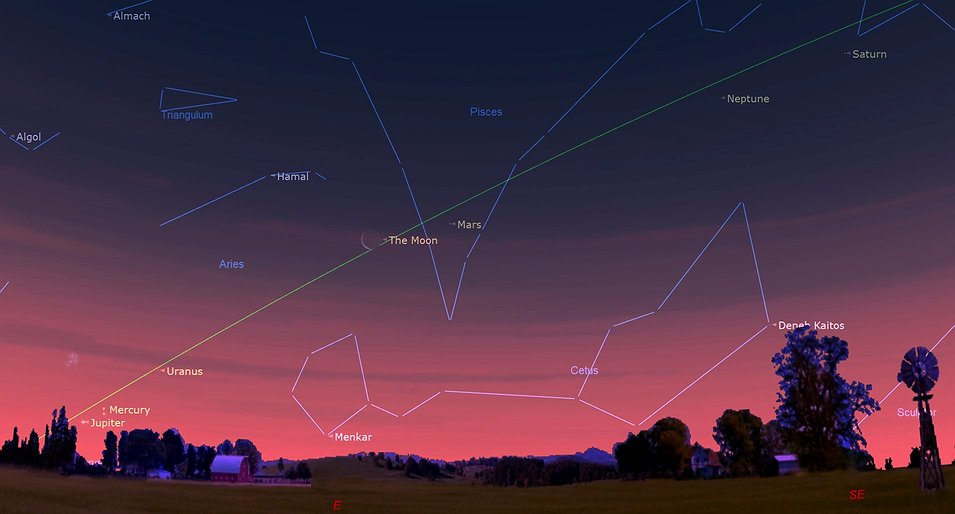Best Night Sky Events for June
• Monday, June 3 — Moon and many planets in morning
In early June, two visible planets and the waning crescent moon will be strung along the ecliptic (green line) in the eastern sky before sunrise. From May 31 to June 5, the crescent moon's eastward orbital motion will carry it past the planets, making it a pretty sight for early risers. The relatively bright planets Saturn and Mars will rise during the wee hours and shine until dawn. They will be the only planets easily seen with unaided eyes.
• Thursday, June 6 — New Moon
The moon will located on the same side of the Earth as the sun and will not be visible in the night sky. This phase occurs at 5:39 a.m. This is the best time of the month to observe faint objects such as galaxies and star clusters because there is no moonlight to interfere.
• Friday, June 14 — First Quarter Moon
The first quarter moon will occur June 14. The moon will complete the first quarter of its orbit around Earth, measuring from the previous new moon, on June 14 at 10:18 p.m. The 90-degree angle formed by the Earth, sun, and moon at that time will cause us to see our natural satellite half-illuminated on its eastern side.
In the first quarter, the moon always rises around mid-day and sets around midnight, allowing it to be seen in the afternoon daytime sky, too. The evenings surrounding the first quarter phase are the best ones for viewing the lunar terrain when it is dramatically lit by low-angled sunlight.
• Thursday, June 20 — June Solstice
The June solstice occurs at 1:51 p.m. The North Pole of the Earth will be tilted toward the sun, which will have reached its northernmost position in the sky and will be directly over the Tropic of Cancer at 23.44 degrees north latitude. This is the first day of summer (summer solstice) in the Northern Hemisphere and the first day of winter (winter solstice) in the Southern Hemisphere.
• Friday, June 21 — Full Moon
The moon will be located on the opposite side of the Earth as the Sun and its face will be fully illuminated. This phase occurs at 6:09 p.m. This full moon was known by early Native American tribes as the Strawberry Moon because it signaled the time of year to gather ripening fruit. It also coincides with the peak of the strawberry harvesting season. This moon has also been known as the Rose Moon and the Honey Moon.
• Saturday, June 22 — The Summer Triangle arrives
After dusk in late June, Vega, Deneb and Altair are the first stars to appear in the darkening eastern sky. Those three bright, white stars form the Summer Triangle asterism — an annual feature of the summer sky that remains visible until the end of December!
The highest and most easterly of the trio is Vega, in Lyra. At magnitude 0.03, Vega is the brightest star in the summer sky, mainly due to its relative proximity to the sun — it's only 25 light-years distant. Magnitude 0.75 Altair, in Aquila, occupies the southern corner of the triangle. Altair is 17 light-years from the sun. By contrast, Deneb, which shines somewhat less brightly at magnitude 1.25, is a staggering 2,600 light-years away from us; but it ranks so high in visible brightness because of its greater intrinsic luminosity. The Milky Way passes between Vega and Altair and through Deneb, which sits high overhead in Cygnus as dawn begins to break.
• Friday, June 28 — Third Quarter Moon
The moon will officially reach its third quarter phase at 2:53 p.m. June 28. In the third (or last) quarter the moon appears half-illuminated on its western, sunward side.
The moon will rise after midnight local time, and then remain visible until it sets in the western daytime sky in the early afternoon. Third-quarter moons are positioned ahead of the Earth in our trip around the Sun. About 3 and a half hours later, Earth will occupy that same location in space. The moonless evening skies in the week that follow this phase are the best ones for observing deep sky targets.
• • •
John Taylor is an amateur astronomer who lives in Hayden.



